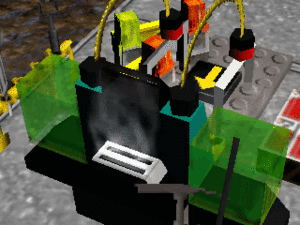Guide:Sequenced textures in LEGO Rock Raiders: Difference between revisions
No edit summary |
No edit summary |
||
| Line 23: | Line 23: | ||
The cheating method.<ref name="rru sequenced guide"/> | The cheating method.<ref name="rru sequenced guide"/> | ||
<code>FORM</code> | [[Wikipedia:ASCII|ASCII]] word followed by a [[Wikipedia:hexadecimal|hexadecimal]] number of a certain length. | ||
<code>SURF</code> | * <code>FORM</code> – a four-byte value found near the beginning of the LWO file, defining the length of the entire file. | ||
<code>TIMG</code> | * <code>SURF</code> – a four-byte value used for each surface | ||
* <code>TIMG</code> – a two-byte value used for each texture | |||
== References == | == References == | ||
Revision as of 02:29, 1 December 2024

This modding guide for the 1999 video game LEGO Rock Raiders details how to add sequenced textures to models in the game.
What are sequenced textures?
In the Windows version of LEGO Rock Raiders, sequenced textures are textures that are animated in-game using a series of bitmap files. Sequenced textures can be used in any object that uses LightWave Scene files for animations: all entries in the MiniFigure, Building, Vehicle, and RockMonster (Creature) types, but not in the Upgrade types or WorldTextures. Certain MiscObjects entries support animations, such as Barriers and Sonic Blasters, while others do not, such as Energy Crystals and Ore. In the original game they are mostly used only for particle effects, such as steam and dust.[1]
Sequenced textures must consist of a series of BMP files ending in numbers. They should be sequential (test if they have to be) and should usually start at 1, though they don't have to (but method 2 will be needed). Numbers are usually padded 2–4 places in the base game (eg. example0001.bmp is 4 places); in practice 2 places should be enough except for very long sequences.
The following requirements:[1]
- The texture files must be 8-bit per pixel (8bpp) BMP files, like all textures in the game.
- The texture file names must end with numbers. The first texture in the sequence should be numbered 1, though starting with 0 or a later number is possible using method 2. The numbers should be padded to the same number of digits for all textures in the sequence; eg.
0001being 4 digits. Numbers are usually padded 2–4 digits in the base game; in practice 2 digits should be enough except for very long sequences. - The LightWave Object file using the sequenced texture must specify it as such. The LWO should link to the first file in the sequence and contain " (sequence)" immediately after the file path.
- The LightWave Object file using the sequenced texture must be used in a LightWave Scene animation file. The LWS should be the same number of frames in length as the sequenced texture, or a number of frames in length that is divisible by the number of frames in the sequenced texture, to ensure that the texture loops properly. As mentioned above, not all objects use animations, particularly upgrade models and certain misc. objects.
Using LightWave 3D 5
This section of the guide details how to create a sequenced texture using LightWave 3D 5. Version 5 was first released in 1995 and was updated to version 5.5 in 1997 and version 5.6 in 1998;[2] one or both of the latter two versions are likely the ones used in the development of LEGO Rock Raiders. For this guide LightWave 3D 5.6 is being used; this version will still run on Windows 10, but users may find its interface difficult compared to later versions. The LightWave file formats changed starting in version 6; these later versions can still save LightWave 5 objects and 5.6 scenes, and can view sequenced textures, but will not properly save sequenced textures in the version 5 LWO format (at least through LW9). To get around this, either save your model without sequenced textures and then load it into LightWave 5, or follow the hex editing section below.
In LightWave Modeler (write this out)
Using a hex editor
The cheating method.[1]
ASCII word followed by a hexadecimal number of a certain length.
FORM– a four-byte value found near the beginning of the LWO file, defining the length of the entire file.SURF– a four-byte value used for each surfaceTIMG– a two-byte value used for each texture
References
- ↑ a b c Sokol, Alan (December 20, 2017) [October 14, 2017]. "Animated Textures on Models". Rock Raiders United. Archived from the original on November 13, 2024.
- ↑ Scott, Dean A.; Vost, Ben (11 September 2024) [2002]. "LightWave History: All the versions of LightWave - so far". LightWave 3D. LightWave Digital. Archived from the original on 26 November 2024. Retrieved 30 November 2024.
